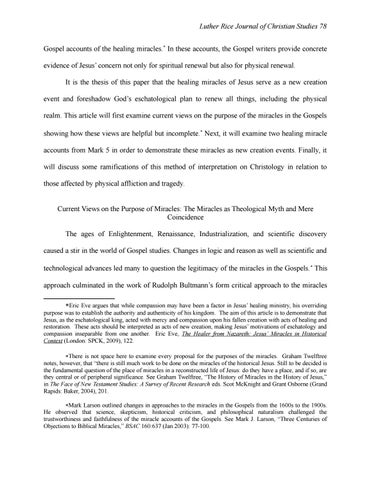Luther Rice Journal of Christian Studies 78 Gospel accounts of the healing miracles. In these accounts, the Gospel writers provide concrete evidence of Jesus’ concern not only for spiritual renewal but also for physical renewal. It is the thesis of this paper that the healing miracles of Jesus serve as a new creation event and foreshadow God’s eschatological plan to renew all things, including the physical realm. This article will first examine current views on the purpose of the miracles in the Gospels showing how these views are helpful but incomplete. Next, it will examine two healing miracle accounts from Mark 5 in order to demonstrate these miracles as new creation events. Finally, it will discuss some ramifications of this method of interpretation on Christology in relation to those affected by physical affliction and tragedy. Current Views on the Purpose of Miracles: The Miracles as Theological Myth and Mere Coincidence The ages of Enlightenment, Renaissance, Industrialization, and scientific discovery caused a stir in the world of Gospel studies. Changes in logic and reason as well as scientific and technological advances led many to question the legitimacy of the miracles in the Gospels. This approach culminated in the work of Rudolph Bultmann’s form critical approach to the miracles Eric Eve argues that while compassion may have been a factor in Jesus’ healing ministry, his overriding purpose was to establish the authority and authenticity of his kingdom. The aim of this article is to demonstrate that Jesus, as the eschatological king, acted with mercy and compassion upon his fallen creation with acts of healing and restoration. These acts should be interpreted as acts of new creation, making Jesus’ motivations of eschatology and compassion inseparable from one another. Eric Eve, The Healer from Nazareth: Jesus’ Miracles in Historical Context (London: SPCK, 2009), 122. There is not space here to examine every proposal for the purposes of the miracles. Graham Twelftree notes, however, that “there is still much work to be done on the miracles of the historical Jesus. Still to be decided is the fundamental question of the place of miracles in a reconstructed life of Jesus: do they have a place, and if so, are they central or of peripheral significance. See Graham Twelftree, “The History of Miracles in the History of Jesus,” in The Face of New Testament Studies: A Survey of Recent Research eds. Scot McKnight and Grant Osborne (Grand Rapids: Baker, 2004), 201. Mark Larson outlined changes in approaches to the miracles in the Gospels from the 1600s to the 1900s. He observed that science, skepticism, historical criticism, and philosophical naturalism challenged the trustworthiness and faithfulness of the miracle accounts of the Gospels. See Mark J. Larson, “Three Centuries of Objections to Biblical Miracles,” BSAC 160:637 (Jan 2003): 77-100.
Luther Rice Journal of Christian Studies, Spring 2019, Volume 3

Issuu converts static files into: digital portfolios, online yearbooks, online catalogs, digital photo albums and more. Sign up and create your flipbook.
